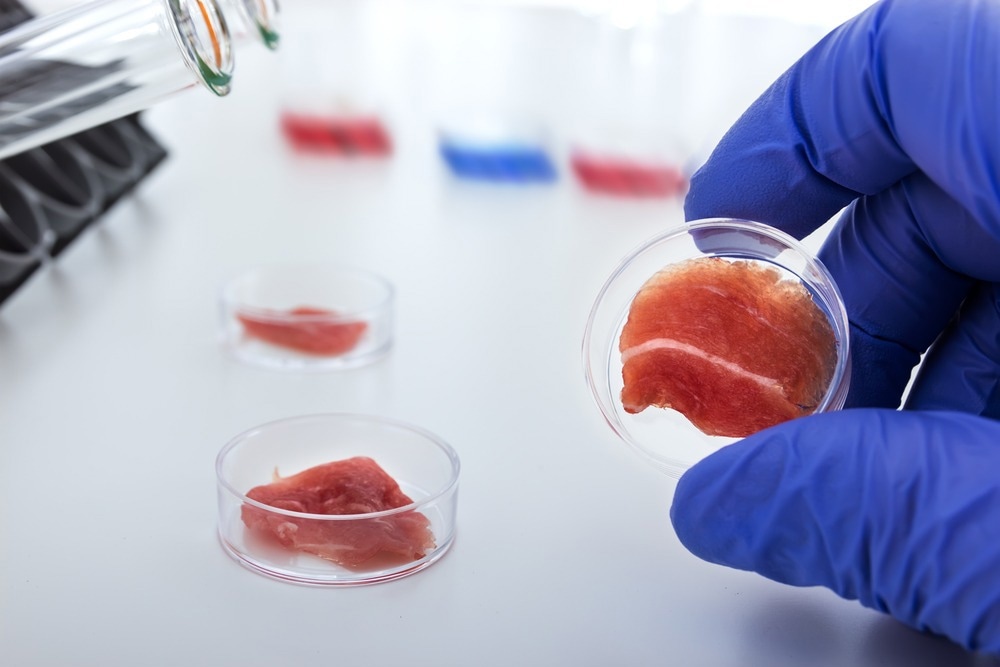In a paper published in the journal ACS Applied Materials & Interfaces, fluorescence quenching was used to detect nitrite ions in processed meat products using a sensing system centered on doped carbon quantum dots. Using this sensor system with a fluorescent probe should assist in establishing a quick and affordable nitrite ion detection technique.

Study: Doped Carbon Quantum Dots/PVA Nanocomposite as a Platform to Sense Nitrite Ions in Meat. Image Credit: Alex_Traksel/Shutterstock.com
Threats Posed by Nitrite Ions
Nitrite ions (NO2–) belong to a class of inorganic chemicals. They are extensively used in drinking water and processed foods.
Nitrite is a popular food additive that is widely used in processed meat products due to its ability to prevent the formation of spoiling microorganisms and improve the color and taste of processed meat. However, nitrite ions interact inside biological systems with amides and amines to generate N-nitrosamines, raising the risk of cancerous formations.
The use of nitrite ions above a certain level harms the human body, causing hypertension, intoxication, and cancer.
Nitrite abuse endangers food safety; therefore, it is critical to create a simple, selective, and highly sensitive technique for detecting nitrite ion levels in food samples.
A field testing device that would allow customers to confirm the nitrite ion levels inside their purchased meat products would be ideal for stringent quality control in the meat industry.
Role of Optical Properties of Nanomaterials in Nitrite Ion Detection
Several techniques for analyzing nitrite ion levels have been documented, including chemiluminescence tests, chromatography, and spectrophotometry approaches.
Most of these procedures are unfortunately costly and time-intensive, comprising of intricate processes that require the excessive use of organic solvents.
Nitrite ion detection techniques focusing on nanoscale materials' optical characteristics are viable alternatives to traditional analysis.
The optical characteristics of nanomaterials can be used due to their remarkable sensitivity, selectivity, and extensive detection range.
Fluorescent systems, including semi-conductive silicon quantum dots, metallic nanoclusters, and carbonaceous nanomaterials, have been studied to detect nitrite ions.
How Can Carbon Quantum Dots Help?
Carbon quantum dots (CQDs) have been identified as potentially useful fluorescent zero-dimensional (0D) nanoscale materials based on carbon.
The remarkable physicochemical qualities of carbon quantum dots, including chemical resistance, minimum toxicity, adjustable fluorescent emission, and a wide absorption range, have increased research focus on carbon quantum dots.
These features enable carbon quantum dots to be used in photocatalytic processes, bioimaging, and chemical sensors.
Carbon quantum dots are commonly used in sensor systems to detect proteins, metals, and nitrite ions. Nonetheless, carbon quantum dots usually have poor quantum yields (QYs), which reduces sensitivity.
Surface-modified carbon quantum dots containing phosphorus, nitrogen, boron, and sulfur may be able to bypass these constraints.
Multiple heteroatoms in extremely small amounts may be used to produce carbon quantum dots doped with these chemicals. The accompanying preparatory procedures may be utilized to create platforms capable of identifying various chemicals, including nitrite ions with good selectivity even in complex matrices like meat products.
Highlights of the Study
The team presented a nitrite ion detection device based on surface-modified carbon quantum dots in this paper. Carbon quantum dots were generated hydrothermally using boric acid, citric acid, and branched polyethylenimine (bPEI) as sources of boron, carbon, and nitrogen respectively.
To achieve a 44.3% quantum yield, the carbon quantum dots were loaded with boron and then functionalized using nitrogen (B,N-Cdot). Hence, an affordable, easy-to-manufacture, and effective nitrite ion sensor was presented for use in processed meat.
The chemical makeup of the B,N-Cdot was examined after purification, which confirmed the boron doping and nitrogen functionalization as predicted.
The nitrite ion detection method was assessed using a colloidal solution. It showed remarkable recovery in an actual meat sample.
The B,N-Cdots were integrated into a thin sheet of highly-fluorescent poly(vinyl alcohol) (PVA/B,N-Cdot).
A sensing device containing a nanocomposite for the detection of nitrite ions was developed to make use of the remarkable optical characteristics of the PVA/B,N-Cdot sheet.
The team used a smartphone application called Photometrix to facilitate the study. Fluorescent signals were recorded at various nitrite levels to produce an easy-to-use nitrite ion sensor offering quick detection.
Important Findings
The detection approach demonstrated that the analyte had good selectivity and could be used to determine high quantities of nitrite ions in processed meat samples.
The findings demonstrated the strong detecting capability of the fluorescent probe in terms of nitrite ion measurement.
A PVA/B,N-Cdot nanocomposite sensing device was ultimately developed. The findings demonstrated that the sensor effectively detected large concentrations of nitrite ions in the solid phase.
More from AZoNano: Sustainable Nanomedicine; An Eco-Friendly Approach to Healthcare
Reference
Carneiro, S. V., Oliveira, J. J. et al. (2022). Doped Carbon Quantum Dots/PVA Nanocomposite as a Platform to Sense Nitrite Ions in Meat. ACS Applied Materials & Interfaces. Available at: https://pubs.acs.org/doi/10.1021/acsami.2c09197
Disclaimer: The views expressed here are those of the author expressed in their private capacity and do not necessarily represent the views of AZoM.com Limited T/A AZoNetwork the owner and operator of this website. This disclaimer forms part of the Terms and conditions of use of this website.